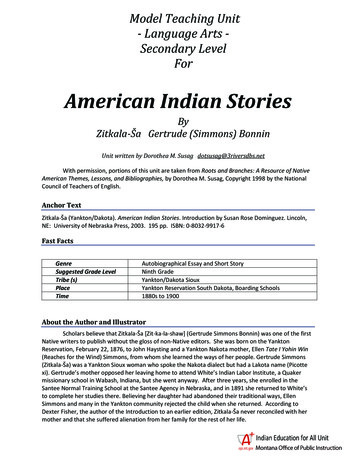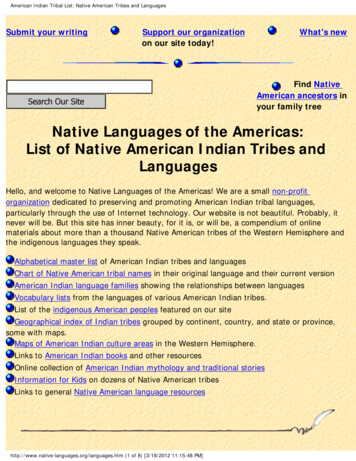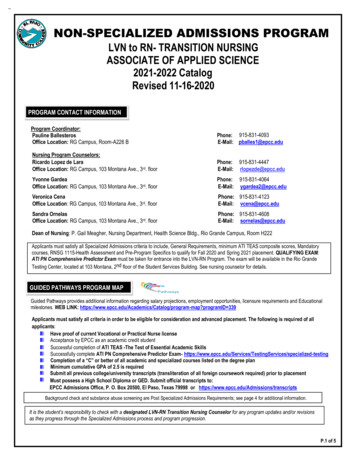
Transcription
Model Teaching Unit- Language Arts Secondary LevelForAmerican Indian StoriesByZitkala-Ša Gertrude (Simmons) BonninUnit written by Dorothea M. Susag dotsusag@3riversdbs.netWith permission, portions of this unit are taken from Roots and Branches: A Resource of NativeAmerican Themes, Lessons, and Bibliographies, by Dorothea M. Susag, Copyright 1998 by the NationalCouncil of Teachers of English.Anchor TextZitkala-Ša (Yankton/Dakota). American Indian Stories. Introduction by Susan Rose Dominguez. Lincoln,NE: University of Nebraska Press, 2003. 195 pp. ISBN: 0-8032-9917-6Fast FactsGenreSuggested Grade LevelTribe (s)PlaceTimeAutobiographical Essay and Short StoryNinth GradeYankton/Dakota SiouxYankton Reservation South Dakota, Boarding Schools1880s to 1900About the Author and IllustratorScholars believe that Zitkala-Ša [Zit-ka-la-shaw] (Gertrude Simmons Bonnin) was one of the firstNative writers to publish without the gloss of non-Native editors. She was born on the YanktonReservation, February 22, 1876, to John Haysting and a Yankton Nakota mother, Ellen Tate I Yohin Win(Reaches for the Wind) Simmons, from whom she learned the ways of her people. Gertrude Simmons(Zitkala-Ša) was a Yankton Sioux woman who spoke the Nakota dialect but had a Lakota name (Picottexi). Gertrude’s mother opposed her leaving home to attend White’s Indian Labor Institute, a Quakermissionary school in Wabash, Indiana, but she went anyway. After three years, she enrolled in theSantee Normal Training School at the Santee Agency in Nebraska, and in 1891 she returned to White’sto complete her studies there. Believing her daughter had abandoned their traditional ways, EllenSimmons and many in the Yankton community rejected the child when she returned. According toDexter Fisher, the author of the Introduction to an earlier edition, Zitkala-Ša never reconciled with hermother and that she suffered alienation from her family for the rest of her life.
Gertrude Simmons went on to graduate from Earlham College in Richmond, Indiana in 1897 andstudied at the Boston Conservatory of Music from 1899-1900. She became an accomplished violinistand public speaker. American Indian Stories includes the three autobiographical essays that GertrudeSimmons originally published in 1900 under the name Zitkala-Ša, or Red Bird, when she was teaching atCarlisle Indian School in Pennsylvania. Once the essays appeared in the Atlantic Monthly, Carlisleauthorities suggested she take a long break for her “health.” She left the school and in 1902 marriedanother Yankton-Dakota, Captain Raymond Bonnin, and they had one child. In 1916, Gertrude SimmonsBonnin became editor of American Indian Magazine, published by the Society of American Indians. Sheand her husband worked on several reservations, advocating for Native American rights during the1920s and 1930s. She was also affiliated with the American Indian Defense Association and Indian RightsAssociation of Philadelphia. According to Agnes M. Picotte in her introduction to Old Indian Legends,Zitkala-Ša’s collection of traditional stories, Zitkala-Ša’s published stories “were meant to inform whitepeople about the American Indians and their unique condition, and a few reveal the turmoil, hurt,anger, and frustration felt by a sensitive, talented American Indian woman.” (xv). With a determinationto persuade new English society of the humanity of Indian people, Zitkala-Ša communicates severallevels of meaning as she interprets her past, and the past of her people, to establish a personal andtribal identity, and this voice is what is so compelling about her work, and why it is relevant in theclassroom.According to Frederick Hoxie in “Exploring a Cultural Borderland: Native American Journeys ofDiscovery” in American Nations: Encounters in Indian Country, 1850-Present, “Gertrude Simmons Bonninexemplified the first generation of native people educated at boarding schools . . . who used their facilitywith English, their ‘civilized’ appearance, and their understanding of American institutions to enterpolitical life. They participated in tribal and village councils, circulated petitions attacking the policies ofthe Office of Indian Affairs, and employed the American legal system to pursue community objectives. . .This effort produced the insight that certain ‘rights’ set Native Americans apart from other residents ofthe United States. That insight inspired tribal leaders to launch a campaign to defend their rights and touse existing political and legal institutions to reclaim control of community government and communallyowned resources"(8).Despite her successes on behalf of all Indian people, she never reconciled the conflicts thatbegan when she left home to attend boarding school. Her writing demonstrates the complexities ofbeing deeply a part of two worlds: the Indian and non-Indian. In it we find a terrible pull from bothworlds, but also the legacy of an American Indian woman who was able to affect positive social change,though it came at a high cost to her culturally and emotionally.On January 26, 1938, in Washington D.C., Zitkala-Ša died of heart and kidney disease and wasburied in Arlington Cemetery.[The biographical information presented above was gleaned from several main sources: FredrickHoxie; Susan Rose Dominguez, the author of the Introduction to the 2003 publication of AmericanIndian Stories; Agnes Picotte, in her Foreword to Old Indian Legends; and Dexter Fisher, the author ofthe Introduction to the 1985 publication of American Indian Stories.]Text SummaryThe first essay (7-45), "Impressions of an Indian Childhood," is separated into seven sections,and the organization is more episodic than sequential—the way memories of childhood might berecalled. But every episode evinces jarring shifts in tone from sweet to bitter to tragic. In this essay,Zitkala-Ša presents the late 19th-century life of a young girl at home on the ADakota@ prairie, with hermother, her extended family, and her tribal community. The writer shares the lessons in beadwork,hospitality, generosity, and the lessons in stories from her childhood; she recognizes the suffering Indianpeople have endured from contact with the white man, and she affirms the humanity and valuable OldWays of her Dakota culture.In the second essay (47-80), "School Days of an Indian Girl," Quaker missionaries take the eightyear-old from her reservation community to a boarding school in the East. Separated from her mother,she suffers under the forces of acculturation and discrimination from the beginning train ride and the2
first days at school. The strange new rules and violent punishments result in anger and a desire forrevenge that builds in the child. The children are shown the Bible and a picture of the Devil which ismeant to inspire fear. But in a dream, her mother takes her on her lap and the fearsome Devildisappears. When a classmate dies, she blames the “woman” for neglecting their needs in these darkand melancholy days. After three years, she returns home to the “Western country” for the summer.There she experiences a disturbing disconnect between home and school, between the way she seesherself and the way her mother sees her. She’s greatly troubled by the changes that have taken place onthe reservation and with her mother. Opposing her mother again, she enrolls in another school in theeast, and subsequently enrolls in college. She enters a speech contest. Despite the overt racism againsther, she wins the contest. Throughout the essay, we see how her traditional values of respect for othersand respect for elders conflict with her need to assert her rights both at home and in the white man’ssociety.In the third essay (81-100), "An Indian Teacher," the narrator returns to teach in an Indianboarding school, remaining separated from her family and community. On her first day, her employerreminds her of the oratory contest, but he doesn’t understand how the prejudice and racism hadaffected her. After some time, her superintendent sends her back to the reservation to recruit pupils forthe school where she finds dramatic changes on the reservation and with her own family. Lovingly hermother welcomes her home and reminds her that Taka Iyotan Wasaka is her solace against the injusticeperpetrated by white people. Her mother curses the white settlers, but her daughter still returns toteach at the Indian school until an illness and utter disillusionment cause her to resign. The essay closeswith the image of “city folks” and “countrymen” who assume the schools have done well to educate the“savages.” The essayist concludes with an implied question: “But few there are who have paused toquestion whether real life or long-lasting death lies beneath this semblance of civilization (99).”Throughout these essays and stories, Zitkala-Ša develops characters who play Iktomi (theDakota trickster/transformer culture hero). It is through these stories that Dakota children learn how tomake sense of the world, how to be wary of those who would manipulate or trick them, and tounderstand the possibility for the same hypocrisy within themselves. Students can look for ways thewriter and characters perform trickery themselves and outsmart the trickster who might cause themharm. Although American Indian Stories presents a polarized view of the Indian/white conflict, ZitkalaŠa has achieved a great deal of sophistication and power in her writing by relying on her Native culture,and then using the English language to assert the civilized and frequently "superior" humanity of herIndian people to a non-Indian audience. Mentioning neither the reservation nor the specific names ofschools, the writer also communicates much more than autobiography; she communicates the veryuniversal experience of Native American children for over half a centuryRecommended Supplemental Materials Atlantic Monthly Magazine, current copies for students to see.Atlantic Monthly (1900), with Zitkala-Ša’s essays online -- Issue 507 January; Issue 508 February;Issue 509 March; 0.htmlBanks, J.A. (1995). “Multicultural education and curriculum transformation.” The Journal of NegroEducation, 64 (4), 390-400. Banks identifies the four approaches to the implementation ofmulticultural education as listed in the table below this list: Social Action, Transformative, Additive,Contributions. https://www.jstor.org/stable/2967262?seq 1Cahoon, Heather (Pend d’Oreille). Elk Thirst. Missoula, MT: University of Montana and the MerriamFrontier Foundation. 2005. 59 pp.Greene, Jennifer (Salish) What I Keep. Albany, NY: Greenfield Review Press, 1999. 77 pp. ISBN087886-141-6;Holmes, Krys with Susan C. Dailey, Teacher Consultant and Dave Walter, Historian. “The EarlyReservation Years.” Montana: Stories of the Land.” Helena, MT: Montana Historical Society Press,2008. (208-226) r, Lowell, ed. Poems Across the Big Sky: An Anthology of Montana Poets. Kalispell, MT: ManyVoices Press, Flathead Valley Community College, 2007. 249 pp. ISBN: 978-0-9795185-0-83
Katanski, Amelia V. Learning To Write “Indian”: The Boarding School Experience and American IndianLiterature. Norman, Oklahoma: University of Oklahoma Press. 2005.Marshall, Joseph M. III (Lakota). How Not To Catch Fish and Other Adventures of Iktomi. Illustratedby Joseph Chamberlain. Music by John Two-Hawks. Eureka Springs, AK: Circle Studios, 2005. 55 pp.ISBN: 0-9768022-0-1 Accompanying CD includes several of the stories.Montana Mosaic: 20th Century People and Events. An educational series from the MontanaHistorical Society. Helena, MT: Montana Historical Society and West of Kin Productions, 2006.Chapter 4: Dislocation/Relocation (Provided by OPI to school libraries and available online: https://mhs.mt.gov/education/MontanaMosaicOceti Sakowin: People of the Seven Council Fires and Bridging the Gap: Native American Education. Aproduction of South Dakota Public Broadcasting. 2008. (Provided by OPI to all school libraries.)Smoker, M. L. (Assiniboine) Another Attempt at Rescue. Brooklyn, NY: Hanging Loose Press, 2005. 64pp. ISBN 1-931236-51-8Sneve, Virginia Driving Hawk (Lakota). The Trickster and the Troll. Lincoln, NB: University of NebraskaPress, 1997. 108 pp. ISBN 0-8032-9263-5 (Introduction explains Iktomi)Susag, Dorothea. Roots and Branches: A Resource of Native American Literature Themes, Lessons,and Bibliographies. Urbana, IL: National Council of Teachers of English, 1998. ISBN 0-8141-4195- (Toutilize background information that this unit requires, teachers will need obtain to this resource.)Susag, Dorothea. "Zitkala-Ša (Gertrude Simmons Bonnin): A Power(full) Literary Voice." Studies inAmerican Indian Literatures. 1993 Winter 3-24. https://www.jstor.org/stable/20736763?seq 1 (Thisessay provides essential background for a comprehensive explanation of the purpose andimplementation required in this unit of this unit)"The People of the Great Plains Parts I and II" and "The People of the Northeast." The NativeAmericans. Video. One CNN Center, Atlanta, GA: TBS Productions, 1994."Wounded Knee." Episode 5. We Shall Remain. DVD. PBS. 2009. Episode 5: 39-46 and 74-78 http://www.pbs.org/wgbh/amex/weshallremain/ All the DVD’s from this series are not specificallyreferenced in lessons because they have just been released. However, they are most valuable.Episodes can be viewed on line.Zacharias, Joanne (2008) (Shakopee Mdewakaton Sioux). Taku Wadaka He? (What Do You See?).Illustrated by Steven Smith. Edina, MN: Beaver’s Pond Press, Inc., 2004, 2008. 30 pp. ISBN:978-1-59298-226-4Zitkala-Ša (Yankton/Dakota). American Indian Stories. Introduction by Susan Rose Dominguez.Lincoln, NE: University of Nebraska Press, 2003. 195 pp. ISBN:0-8032-9917-6Zitkala-Ša . Dance in a Buffalo Skull. Illustrated by S.D. Nelson (Lakota). Pierre, SD: South DakotaState Historical Society Press, 2007. ISBN: 978-0-9777955-2-9Zitkala-Ša (Gertrude Simmons Bonnin) Old Indian Legends. Lincoln: University of Nebraska Press,1985. 165 pp. ISBN: 0-8032-9903-6 (See review in Roots and Branches 212)4
Implementation Level, Essential Understandings and MT Content StandardsImplementationLevels4321Social JusticeTransformativeAdditiveEssential Understandings - Big Ideas1-There is greatdiversity between tribes.2-There is greatdiversity between individualswithin any tribe.3-Ideologies, traditions,beliefs, and spiritualitycontinue through a system oforal traditions.ContributionsMontana ContentStandards4-Tribes reserved a portionReading –of their land-base through1.1, 1.2, 1.4, 1.5,treaties.2.1,2.2, 2.6,4.4,4.5, 5.3, 5.55-History is told fromsubjective experience andperspective.6-Federal Indian policiesshifted through six majorperiods.Writing –1.1, 1.2, 1.3, 1.4,2.1, 2.2, 2.3, 2.4,2.5, 3.3, 4.3, 5.1,5.2, 6.1, 6.2, 63,6.4Literature –Social Studies1.1, 1.2, 1.3, 1.4, – 1.1, 2.6, 3.2, 3.3,1.5, 1.6. 2.1, 2.4, 3.4, 3.5, 3.7, 6.1,4.2, 4.3, 5.1, 5.3 6.3, 6.47-Three forms ofsovereignty exist in the US federal, state, & tribal.Learning Targets I understand the influence of the literary, cultural, and historical experience and tradition on therhetoric in Zitkala-Ša's three autobiographical essays.I appreciate the importance of landscape in the lives of all people.I understand the impact of Indian boarding schools and Western settlement on Native Americanpeople and the ways one individual survived both culturally and personally.I apply my knowledge about irony, tone, and the different narrative and editorial voices which mayexist in autobiographical essays such as these.I make connections from my reading of American Indian Stories to my life and to the world outsidemy classroom.I identify main ideas, combine background information with the main text, draw inferences fromcontextual clues and from details and figurative language to better understand the levels ofmeaning in American Indian Stories and the poetry and stories in this unit.I respond to the writing in American Indian Stories in a variety of written modes and genres, as wellas speaking and listening and making appropriate oral and media presentations.I understand how the 6 Traits of Writing appear in American Indian Stories and related texts andhow they contribute to its effectiveness.I know my own strengths and weaknesses in reading and writing, and I set goals for improvement.I know how historical and cultural influences give meaning to American Indian Stories and otherrelated works.I appreciate the uniqueness of the Yankton people and their heritage, while I also understand theaspects of our common humanity, both within and between cultures that American Indian Storiesportray.Day by Day Plan - StepsoThis single unit provides two approaches for a study of Zitkala-Ša's stories:#1 - Approach and Reading in Day 4 - 12: This reading focuses on comprehension, engagementwith the story, and students’ connections with their own lives.o Although Day 4 – Day 12 are allocated for the first reading, it’s certainly possible tomove through the text faster or more slowly, depending on students' ability levels andavailable time.o You may decide to have the first and second readings going on at the same time,possibly with different groups of students, and possibly with each essay.5
o#2 - Approach and Reading in Days 15 – 19: This reading requires a more critical approach andsubsequent understanding based on historical, cultural, and literary background knowledge.Because the second reading employs a more sophisticated approach to studying literature thanthe first, you might chose to skip this extension if it proves too challenging for your students’grade level or abilities.Zitkala-Ša's work is contemporary American Indian literature which deserves to be read it in lightof the contexts that have informed it as well as the various audiences that read it. For the literarycontext, students will learn about the tradition of storytelling and Iktomi stories in particular. In thesecond reading of the texts, students will understand how the author’s exposure to Christianity andPuritan values also contributed to her literary and linguistic contexts. The Appendices provide morecultural, historical, and geographical contextual information.The available resources will help students read and respond to her writing, making it possible forthem to appreciate the literary excellence that has contributed to Zitkala-Ša’s reputation as a powerfulwriter worth serious study.The Portfolio assignments are written to meet the needs of diverse classes and students.Teachers will determine the requirements for each assignment, as well as how much time is needed forreading and writing, whether in or out of class.Day OnePrereading Activity:A. Historical and Geographical Context -- Students will locate theYankton Reservation on a map and begin their understandingof the Yankton history and Dakota storytelling tradition. Dividethe class into inquiry groups and assign one of the followingquestions to each group.1. What are the South Dakota Indian Reservations?2. Where is The Yankton Reservation? What can you learnabout it?3. Who are the Sioux?4. What do the Sioux call themselves?5. What are the different bands within the Sioux Nation?6. What are the Fort Laramie Treaty of 1868, and theAgreement of 1876?7. Who is the Trickster/Transformer or Iktomi?8. What were/are the Indian Boarding Schools in North andSouth Dakota?The following links might help students search for answers:1. rvations in South Dakota, with links to specific tribes. Italso includes complete scripts of some treaties.2. http://www.fortpecktribes.org3. px4. https://sdtribalrelations.sd.gov/tribes.aspx5. eaty/Sioux Treaty of 1868Use these and other sites you can access when searchingfor “Yankton tribes” or “Yankton Reservation.” Studentsshould be aware of the perspective of various sites:tourism, Native interests, government documents, etc.They may find photos, both historical and contemporary.6Teacher Tip: You may use theinformation in the sources listed below toprompt their thinking. We don’t want todrown them in too much information.We just want to build on their previousknowledge and stimulate their curiosityto begin the unit.1) Appendix A: Trickster/ TransformerFigure from Roots and Branches(41-42).2) Appendix B: Yankton ReservationHistory as Reported in AnnualReports of the Department of theInterior and Indian Affairs(1974-1902)3) https://www.sdpb.org/learn/nativeamerican/oceti/ (OPI hasprovided the film Oceti Sakowin:People of the Seven Council Fires andBridging the Gap: Native AmericanEducation to school libraries)4) Susag, Dorothea. "Zitkala-Ša(Gertrude Simmons Bonnin): APower(full) Literary Voice." Studies inAmerican Indian Literatures. 1993Winter 3-24.https://www.jstor.org/stable/20736763?seq 1 (This essayprovides essential background for acomprehensive explanation of thepurpose and implementationrequired in this unit of this unit.)
7. https://www.sdpb.org/learn/nativeamerican/oceti/ (OPI has provided the film OcetiSakowin: People of the Seven Council Fires and Bridging the Gap: Native American Educationto school libraries)8. "Chapter 4: Dislocation/Relocation." (15 minutes) Montana Mosaic: 20th Century People andEvents. An educational series from the Montana Historical Society. Helena, MT: MontanaHistorical Society and West of Kin Productions, 2006. (Provided by OPI to school librariesand available online: https://mhs.mt.gov/education/MontanaMosaic.)B. Portfolio #1 - Keep track of brief notes from research,including sources of information. Students can take notes inthe portfolio while conducting internet research individuallyor in small groups. This also helps in teaching the writingprocess.C. Sharing: Students will share the results of their research forthe last 15 minutes of the class period. This does not need tobe developed knowledge. It’s merely an introduction.Teacher Tip: PortfolioAssignments: You might make someassignments optional or students mayselect from available choices. Dependingon the students, some Portfolioassignments may be homework whileothers may be completed in class.Day Two and ThreePrereading Activity:A. Literary Context -- Atlantic Monthly Magazine -- Explain how these stories were first publishedin this literary magazine with a sub-title of "A Magazine of Literature, Science, Art and Politics."Although the text as published today looks like a book for children or young adults, the audiencein 1900 was educated, non-Indian adults who lived in the eastern United States. This unit willhelp students understand that there is much more to Zitkala Ša’s writing than meets the eye.https://collections.library.cornell.edu/moa new/browse.htmlB. Listen to Joseph M. Marshall III (Lakota) tell Iktomi stories onthe CD that accompanies the picture book, How Not to CatchTeacher Tip: If possible, invite a localFish and Other Adventures of Iktomi. John Two Hawks, theelder or traditional storyteller to yourmusician on the CD comments: “Although these tales doclassroom. If it is appropriate, ask themcome from Indian culture, they are not 'Indian stories'. Theseto tell a story about their tribes’are tales that impart the value of honesty, humility, integrity,trickster/transformer figure. A wealth oflove, selflessness, perseverance, faith, respect, compassiononline speakers is available from theand so many other qualities we all need, young and old, toTrailtribes.org online site:http://www.montanatribes.org/digital arlive a good life.” As a class, check out his website:chives/matrix.php?page introwww.johntwohawks.comAlso, Turtle Island Storytellers Network isPlease consider the following:a website with Montana tribal Most of the lessons in these stories are implicit ratherstorytellers listed.explicit. It might help to put the above list of valueshttp://www.turtleislandstorytellers.net/tiin bold on the board to stimulate some ideas.s montana.html You may also read Flute music provides background for the stories, butfrom Zitkala Ša’s collection of Iktomithe music continues for about 13 more minutes afterstories: Old Indian Legends.the last story. One segment is a song about Iktomiflying. You may play the CD while students draw orwrite. Play the stories one at a time, and invite students to draw images while they listen. Asthey listen, tell them to think about these things as they listen:o What lessons did the story teach?o Where did you find yourself in the story?o What were some appropriate or inappropriate behaviors exhibited in the story? At the end of each story, have students share their thoughts.7
Stories on the Marshall CD:1. (3-10)13 minutes -- “Iktomi and the Fish”: Iktomi tries to catch a very old catfish and learns thelesson that things are not always as they seem.2. (17-24) 13 minutes --”Iktomi and the Trees”: Wind, in one of her moods, playfully causestrouble for Iktomi as he tries to pick buffalo berries and then gets caught between two trees.3. (25-34) 16 minutes --“Iktomi Flies”: Unprepared for winter, Iktomi tries to fly south with goosewho tells him he can fly if he just believes. Seeing him flying with the geese, a two-legged laughsand it makes him angry. Unable to ignore their ridicule, he falls from the sky into the camp.“Too much anger and not enough believing.” A woman takes care of him all winter, and whenspring comes, he leaves and forgets to thank her.4. (34-41) 18 minutes -- “Iktomi and the Meaning of Truth”: Iktomi tricks Old Bear and gets plumsas his prize. But then a wolverine comes to the prairie and Old Bear doesn’t have theconfidence to fight him off. Knowing he can’t be as strong as Old Bear, the other animalsconvince Iktomi that he must do the right thing: tell the truth about how he had tricked OldBear.C. Introduce Zitkala Ša and American Indian Stories with a brief biography of Gertrude Bonninfrom the Introductions by Susan Rose Dominguez in American Indian Stories and Agnes Picottein Old Indian Legends.Day FourApproach and Reading #1A. Begin by reading aloud to the students (7-11) “My Mother,” the first section from “Impressionsof an Indian Childhood.”B. Portfolio #2 Write in response to the following prompt: D. I. C. E. Write for half a page aboutwhat Disturbed, Interested, Confused, or Enlightened you as you listened to this short section.C. Activity: After they write, ask students to share their responses in a circle discussion.D. Assign: (12-45) Sections II – VII.Day FiveA. Getting at the Meaning Questions for Small Group Discussion or Reading Check:1. What appropriate behaviors does the child understand and practice in “The Legends”?2. What question is left unanswered? What’s the effect of that on you as a reader?3. Explain the ritual of storytelling that the children play.4. How does the mother help her daughter overcome her fear of an old warrior?5. How does the grandfather protect the child’s feelings?6. Describe the gathering of warriors and women.7. Why does the mother forbid her daughter to touch the plum bush?8. What does the girl remember about corn and the squirrel?9. Why does the mother tell her daughter to leave the squirrel alone?10. Why does her mother oppose, and her aunt support, her leaving for school?11. Why does the child want to go?8
B. Portfolio #3 Make two columns on a sheet of paper. Write“Confused” at the top of one, and “Surprised” at the top ofthe other. In ten minutes, list what you found confusing onthe left and what you found surprising on the right, usingphrases or short sentences.C. Activity: Students will share and discuss their lists in smallgroups. Following the small group discussion, speakers fromeach group will share the most common or interestingresponses with the whole class.Teacher Tip: Portfolio #3 Activity:If student confusion arises from limitedbackground knowledge, you may helpstudents recall what they learned fromtheir preliminary research. You may alsoprovide additional Historical andGeographical contextual backgroundinformation found in Roots and Branches- The Yankton Reservation: 1858-1902(91-93). It could help answer some of thestudents’ questions. However, theprimary focus for this first read is toengage the students in the story and tohave them make connections betweenthe characters and themselves.Day Six and SevenA. Activity: Class will brainstorm in a teacher-lead discussion:What has this child learned from her mother? Students mayconsider practical skills, understanding of the world aroundher, spiritual matters, behaviors toward others, what to fearand why, what to value. Some lessons are positive and some negative.B. Portfolio #4 Think about what this child has learned, and remember when you were seven andeight. Write about the important lessons you have learned from your mother or father.C. Portfolio #5 You will make two drawings: (1) This story takes place in a neighborhood.Imagine what it looks like and illustrate the story with a map of places mentioned. (2) Draw amap of your neighborhood or town. What are the places and people (their homes) that youwill choose to include. Write a short paragraph about the similarities or differences betweenwhat you chose to include and what the essayist included.D. Portfolio #6 List the elements you might include in your own memoir entitled “Impressions of. . . Childhood” that might be published in the Montana Historical Society's Montana theMagazine of Western History. Zitkala-Ša has seven sections. How many will you have? Willyou describe your home, parents, your friends, your chores, what makes you happy or sad orfearful. What stories will you include?Day EightA. Begin by reading aloud to the students (47-51) “The Land of the Big Red Apples,” the firstsection from “The School Days of an Indian Girl”.B. Portfolio #7 Write in response to the following prompt: D.
(Zitkala-Ša) was a Yankton Sioux woman who spoke the Nakota dialect but had a Lakota name (Picotte xi). Gertrude’s mother opposed her leaving home to attend White’s Indian Labor In










